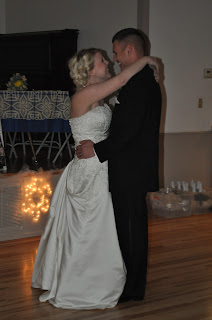As always, diabetes traveled with us, and provided a few challenges along the way. We made it to Washington on Friday morning only to open Sarah's diabetes kit (a small backpack) to find a can of apple juice had spilled. Everything was juiced, including the meter remote for her insulin pump. We ended up using a spare pump during the rest of the trip - which made things interesting as I had to reach under a full length dress several times during the wedding reception to check her pump and provide insulin.
We had an 11am appointment on Friday to get our fingers and toes beautified and have a chance to finally meet the bride's family in person. This started (and ended) wonderfully and we had a great time socializing with our new family. Sarah loved the massage chair she sat in for her pedicure.
During the manicure, diabetes decided to give us a little run for our money, because clearly it was WAY too much to ask to keep things simple. Sarah was doing great, keeping her wet toes still while a french manicure was applied to her fingers. Suddenly, and with no warning, she turned to me and began to wail that her stomach hurt. The wail was what got me, it wasn't anything like the sound Sarah usually makes when crying. I immediately directed her dad to check her bloodsugar and while he was in the process of poking her finger, she passed out - which pretty much gave us all a heart attack. Her auntie was right there with a tube of cake icing and began squeezing it into her mouth. I think she was probably out 10-20 seconds, but it seemed much longer. She began to wake, pale and sweaty, and auntie began shoveling cookies into her mouth to bring her blood sugar up. This was our first serious hypoglycemic event in the eleven months since she was diagnosed.
 |
| From left: Amanda, Michelle, Sarah, Ashley - Sarah is the picture of health only a few hours after passing out from hypoglycemia. |
The wedding day came and I was a bit nervous. Sarah had a lot of responsibility. As a junior bridesmaid, she'd obviously walk down the aisle and stand during the ceremony. Additionally, she had to sing a song mid ceremony. We arrived at the church about two hours before the wedding so the photographer could take pictures. Uh oh. It's freezing outside and that's where the pictures are being taken - 1st potential bloodsugar nightmare, serious change in temperature, shivering, stress. So I poked Sarah about every fifteen minutes during the two hours before the wedding and kept having her take little bits of food to keep her sugar up. 15 minutes before the ceremony she was still only at 100, and I was very nervous about having a repeat performance of the manicure incident during the ceremony, so I forced her to eat a whole banana, hoping (for a change) for the crazy banana spike.
 |
| Amanda and Sarah in their beautiful bridesmaids dresses |
The ceremony was amazing. My little boy married his love. And Sarah made it through without a hitch. She enjoyed a big cookie at the dessert reception, then danced the night away.
 |
| Dancing the night away |
